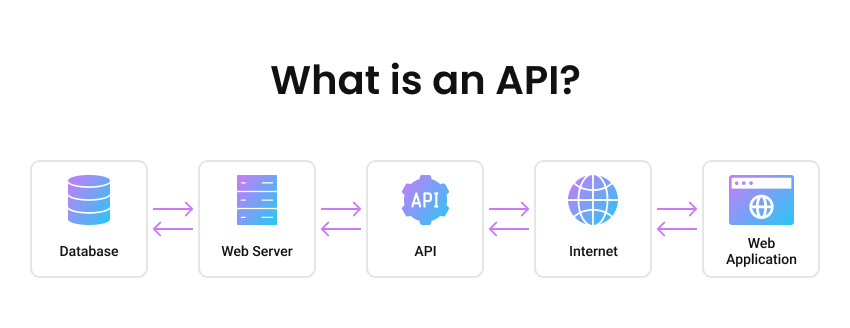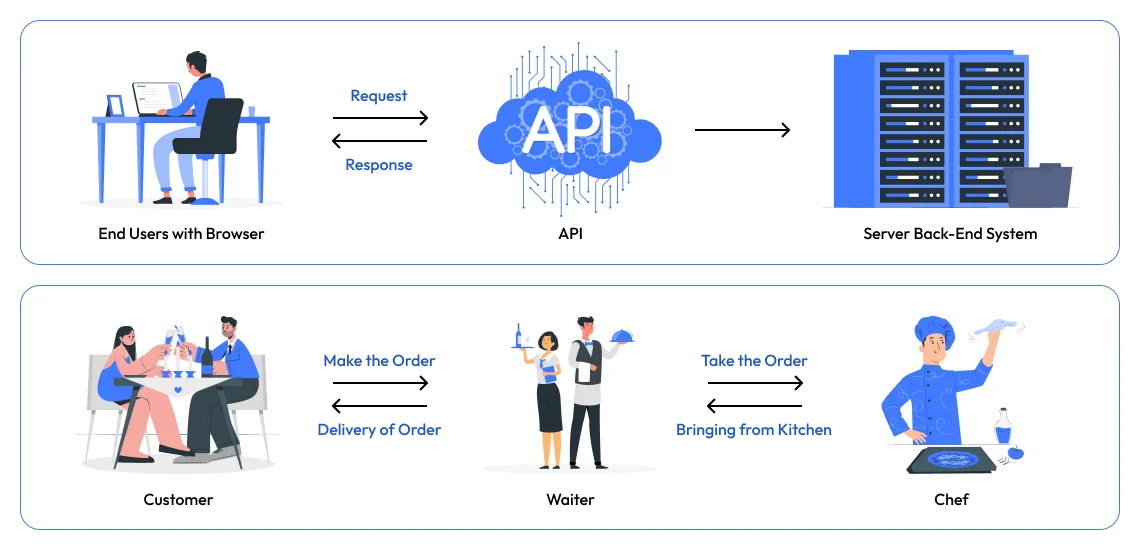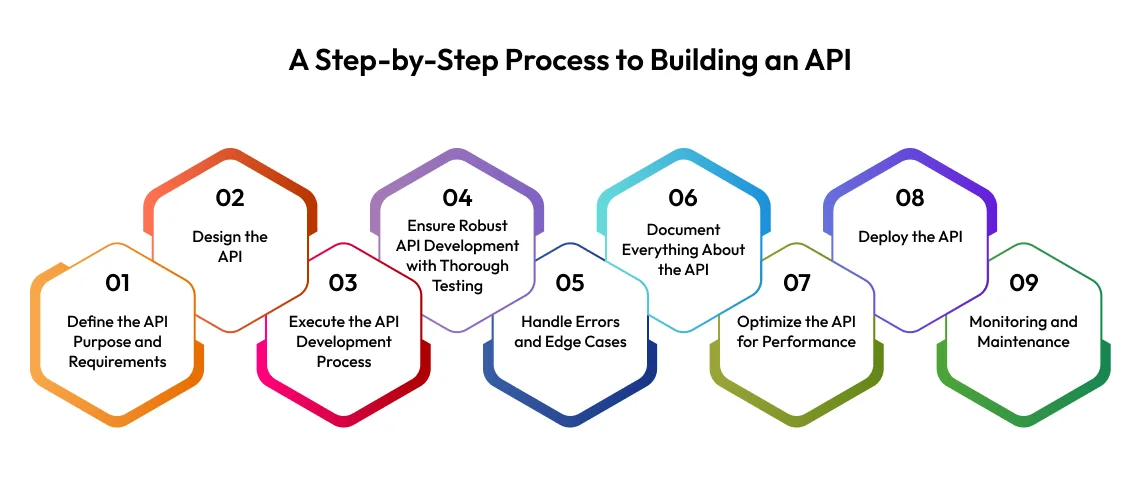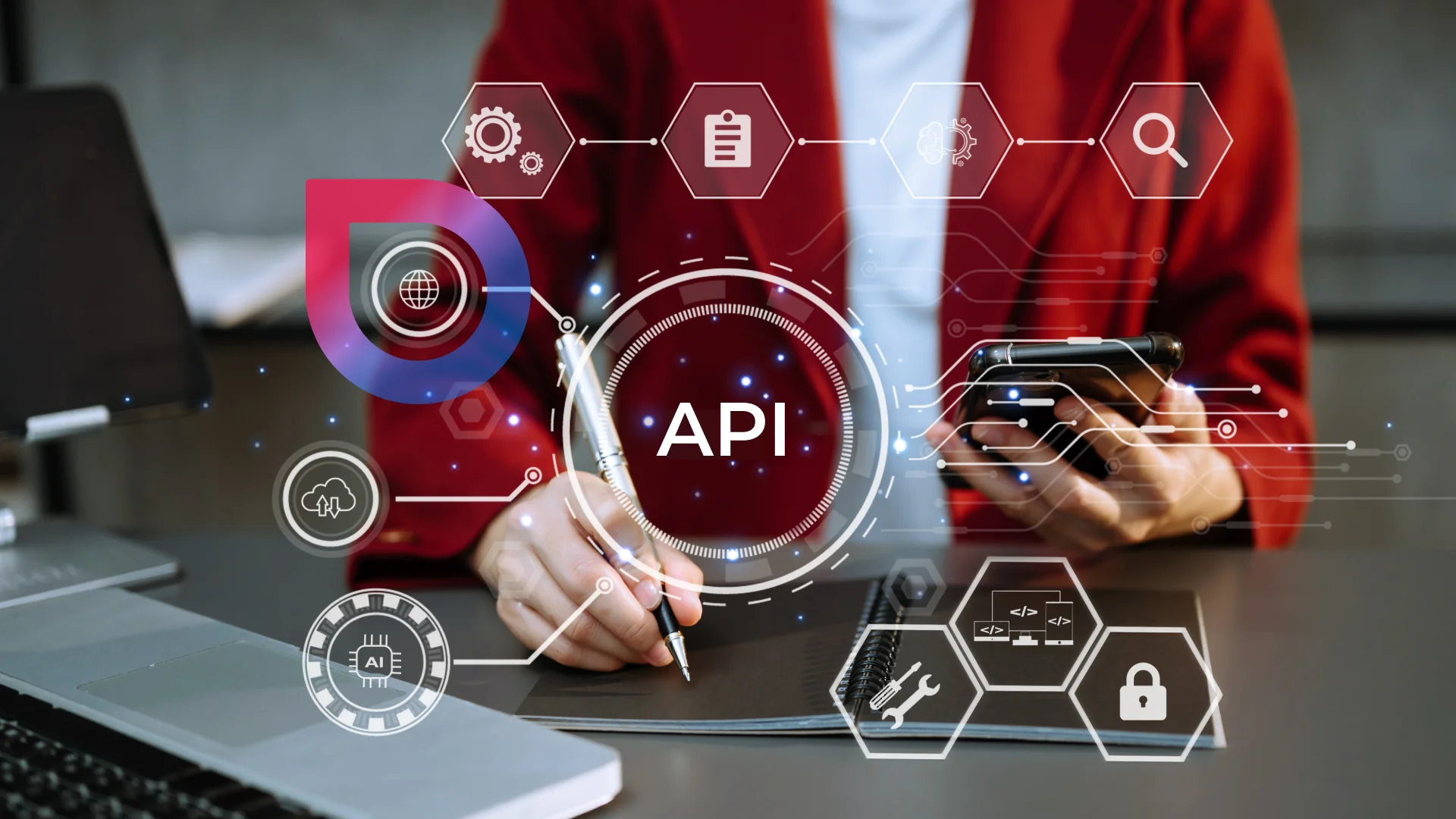Guide to API Development: Process, Examples, and Best Practices
- Web
- July 5, 2024
Have you wondered how one app lets you explore multiple services, book services, and pay online seamlessly? It’s all because of APIs. But do you know what are APIs and how they work and how to develop an API? Well, this API development guide is your gateway to access all the information, from introduction to API development with best practices.
In today’s interconnected digital landscape, APIs (Application Programming Interfaces) development have become the backbone of software development, enabling different systems and applications to communicate and work together seamlessly.
What is an API?
API, or Application Programming Interface, is a set of rules and protocols that allows one software application to interact with another. APIs define the methods and data formats that applications can use to communicate, facilitating the integration of different systems.

They act as intermediaries that enable the transfer of data and functionalities between applications, whether they are within the same system or across different platforms.
How Does an API Work?
Let’s take an example of our usual interaction with apps to better understand how API works.
For example, you’re hungry and want to order something to eat, but you’re feeling too lazy to go outside and bring food home. Then, you decide to use online food delivery app to order your favorite food from your preferred restaurant. You check the menu and go ahead with the checkout process, but you don’t have cash in hand to opt for the COD (Cash on Delivery). Luckily, the app has an integrated payment gateway, allowing you to pay online from your bank account.

If we understand technically just for the restaurant list fetching, then the working of APIs is as follows:
STEP 1: As a user, you open the food delivery app and search for Italian restaurants in your area.
STEP 2: The API associated with the app sends a request (usually an HTTP request) to a restaurant listing API to get the available Italian restaurants. (the GET request can look like this: ‘GET https://api.fooddelivery.com/restaurants?cuisine=Italian&location=YourCity.’)
STEP 3: API processes the restaurant listing API and receives the request. It processes the request by querying its database for Italian restaurants in your specified location.
STEP 4: API responses to the app with a list of Italian restaurants, including details such as name, address, rating, and menu.
STEP 5: Lastly, the app receives the response and extracts the relevant data (restaurant names, addresses, ratings, and menu items) (usually in JSON or XML-like standardized format).
In short, you can say that APIs are indispensable in modern software development services, offering a framework for building dynamic, scalable, and interoperable applications. Now, you must be curious to know the working of APIs that makes them essential for an application.
STEP 6: The app then displays the information (restaurant name, location, delivery time, ratings, etc.) in a user-friendly format on your screen.
So, here, the online food ordering app apps like UberEATS act as endpoints and APIs as intermediary gateways that form the bridge between the two services.
API Development Process: Step-By-Step
The API development process should be planned carefully, as you have to create your API to be secure and high-performing to handle process requests at a certain rate. So, the API development typically includes the following steps:

1. Define the API Purpose and Requirements
API planning should start with clearly defining what the API is intended to achieve. Is it for accessing data, integrating services, or something else?
Then, determine who will use the API. There might be chances your API users could be internal developers, third-party developers, users using different mobile applications – needing your API, etc.
Lastly, you have to consider API features and endpoints, and choose a documentation format (whether it would be an OpenAPI/Swagger, RAML, or API Blueprint), along with request/response formats, authentication, and error handling in the specification.
2. Design the API
Based on the type of API development you choose to undertake, you should consider its associated method to seamlessly perform the operations.
For example, if opting for the RESTful API development, you have to adhere to REST principles for its effectiveness. Along with that, you also have to use the appropriate HTTP methods, which include GET for retrieving data, POST for creating data, PUT for updating data, and DELETE for deleting data.
To name the resources, use clear, consistent, and intuitive naming conventions for resources.
To ensure the statelessness of the REST API, make sure that each request from a client contains all the information needed to process the request.
Ensure that you have all the plans for API versioning and security of the same. In the case of versioning, you can include the version number strategy in the URL, like /api/v1/resource.
Lastly, you do want to design a secure and robust API, which asks for implementing authentication methods (like API keys, OAuth, or JWT) and strategies to prevent it from getting into the traps of SQL injection and XSS.
3. Execute the API Development Process
For the API development, you have to first set up the environment by selecting the right programming language and framework for the API, along with API development tools.
To start building an API, you’ve to structure the project by organizing directories and files logically, developing endpoints, handling requests/responses, implementing robust data validation and error handling mechanisms, and lastly integrating API authentication and authorization controls.
Once done with all necessary API development setups, go for the database integration, which includes the selection of databases (SQL or NoSQL), schema design, and implementation of CRUD operations for resources.
4. Ensure Robust API Development with Thorough Testing
Divide your API testing into four parts. First should be Unit Testing to thoroughly test each component of the API to ensure they work as expected.
The second should be Integration Testing to test the API that has an idea that each integrated component is working seamlessly together.
The third test should be the end-to-end testing, which helps to verify the entire workflow, from the client making a request to the API responding.
The last should be to test how much load of requests the API can handle.
5. Handle Errors and Edge Cases of API Development
Based on the errors and bugs you encounter during the API testing time, it’s time to provide a respective solution for the same for a seamless API user experience. Implement comprehensive error handling to provide meaningful error messages.
For example, in Express.js, you can mention it like as done in the following code:
app.use((err, req, res, next) => {
res.status(500).json({ error: err.message });
});Lastly, validate incoming data to ensure it meets required formats and constraints.
6. Document Everything About the API development
Use tools like Swagger UI, Postman, or Redoc to generate comprehensive API documentation to save up on time. While doing that, please ensure that the documentation covers all endpoints, parameters, and response formats.
Not just that, but also try to provide interactive documentation where users can test API calls directly.
7. Optimize the API developed for Performance
You need to ensure the three things to ensure that your API performs well, including caching, rate limiting, and load testing. But, how to do that?
- You can implement caching strategies to reduce load times.
- Protect your API from tons of requests being raised at a time by limiting the number of requests a client can make in a given time period.
- Use tools like JMeter to simulate high traffic and test your API’s performance under load.
8. Deploy the API
Now, the dilemma is which cloud platform to choose for your API: AWS, Azure, and Google Cloud. It asks for knowing different types of cloud computing platforms and services to choose the one wisely.
Moreover, you may opt for the DevOps methodologies to reduce time-to-market by setting up CI/CD pipelines for automated testing and deployment. Popular DevOps tools like Jenkins, Travis CI, or GitHub Actions can help you significantly.
9. Ensure the Robustness of Your API With Proactive Monitoring and Maintenance
After the deployment of your API, it’s a must to actively log and monitor its performance, for which tools like ELK Stack, Prometheus, or New Relic can certainly help you. Along with that, you can also configure alerts for any unusual API activities or errors.
After receiving data, it’s time to update the API to fix bugs, add new features, and improve performance, while handling deprecation of old API versions carefully.
API Development Best Practices
You may get into the loopholes and traps of the API development if you’ve not followed the API development best practices. So, let’s know that:
- Design your API following the REST architectural style for simplicity, scalability, and ease of use.
- Use versioning to easily jump to versions and ensure future evolvements are not overlapping the previous API versions.
- Design efficient endpoints, implement caching, and consider pagination for large data sets.
- Prefer JSON as the primary data format for requests and responses.
- Create a stateless API design that can easily scale horizontally.
- Implement HATEOAS (Hypertext As The Engine Of Application State) by including links in responses to guide users to use the API efficiently.
- Utilize HTTP methods like GET, POST, PUT, PATCH, and DELETE appropriately for different operations.
- Keep your API design consistent across all endpoints and resources.
- Implement data encryption and SSL/TLS to ensure the robust security of the API.
By following all these API development best practices, you can develop a robust, secure, and well-documented API that meets the needs of its users and can scale to handle growth.

Most Popular APIs for Integration/ App Development
When thinking of maps, then Google Map API comes first – for payments – PayPal, Stripes, and RazorPay, to access weather information – Weather API, and many others. So, let’s get to know the popular and most integrated APIs that you may want to integrate into your application:
- Google Maps API: A RESTful API widely used for integrating mapping and location-based services into applications.
- Twitter API: Businesses integrate Twitter API in their application to offer users features like tweet posting, user information retrieval, and trend analysis.
- PayPal API: Widely used for integrating secure payment processing into applications and websites.
- Stripe API: Another popular payment processing API, known for its developer-friendly approach and extensive documentation.
- Twillio API: Many businesses and developers prefer to integrate Twilio API with their app to provide communication features like SMS, voice calls, and video calls into applications.
- Weather API: Allows applications to access weather data and forecasts. You may find various weather APIs out there, such as WeatherAPI.com, Forecast, OpenWeatherMap, Meteosat, Tomorrow.io, etc.
- WhatsApp API: Using the WhatsApp Cloud API, developers can build chatbots and automated messaging suites (templates, quick replies, and message sending) to promote their business services and offer users with world-class 24/7 handy customer service experience.
- Booking API: It’s highly used by online travel service providers to offer users an easy gateway to book flights, hotels, and activities nearby to their travel locations.
Apart from these, there are many others as well, but these APIs have gained popularity due to their robust functionality, extensive documentation, and the value they add to applications across various domains. They have been widely adopted by developers, businesses, and providers of software product development services to enhance their products and services
Different Types of API
In the modern enterprise app development approach, APIs are broadly imbibed terms and assets for the app architecture. Now, when it comes to bifurcating the APIs, the main types are often mixed and misunderstood with REST, SOAP, and other terms followed by the term APIs.
So, there are typically four main types of Application Programming Interfaces (APIs) that everyone should know:
1. Open APIs
These are also known as Public APIs or External APIs, which can be used by all developers and businesses even if they haven’t contributed to their development.
Such APIs are often developed by entities who would like to make their online services and data public and make such available for other businesses to use.
2. Partner APIs
Partner API is a type of API designed to enable interactions between business partners, facilitating collaboration and data sharing between organizations.
Unlike public APIs, which are available to any developer, Partner APIs are usually restricted to specific, trusted partners and require authentication and authorization for access.
The motive behind such APIs is not monetization goals but an exchange of data and services to enhance business processes and customer experiences.
3. Internal APIs
Internal APIs, as the name suggests, are also known as Private APIs, which are used within an organization to facilitate the integration of various internal systems, services, and applications.
Some of the common use cases of Private APIs include microservices architecture, where different services of a software application (e.g., front-end with back-end). They can also help to automate internal workflows and processes.When used together, many people have misunderstandings between Microservices and API.
For example, consider an ERP/HRMS system, allowing employees to access information about organizations, like new joiners, their financial information (pay slips, tax info, CTC breakdown, etc.), attendance, office canteen menus, etc.
4. Composite APIs
Composite APIs are a type of API that combines multiple individual API calls into a single endpoint, providing a unified interface for developers to interact with.
They enable the orchestration of multiple API calls in a predefined sequence or based on certain conditions. This orchestration can involve chaining API calls, handling dependencies between them, and merging results as needed.
Consider dashboards of the application that offers a consolidated view of all important data fetched from multiple services in a single screen view.
Popular API Architectural Styles and Protocols
You now know that APIs are used for data and service exchanges, but do you know how they are done? Well, APIs can do all the wonders of data and services accessing all thanks to associated protocols and architectures. So, here are the widely known API architectures and protocols.
1. REST API
REST (Representational State Transfer) is an architectural style for designing networked applications. APIs built with this architecture are also known as RESTful APIs, which can connect services directly or through intermediary services such as load balancing and API gateways.
It uses a client-server model where resources are identified by URIs (Uniform Resource Identifiers), and interactions are stateless. Moreover, it uses HTTP methods like GET, PUT, POST, DELETE) and CRUD (Create, Update, Read, Delete) operations on the data entities.
It is popular for web and mobile app development for its lightweight and efficient support to ensure seamless communication between different services over the internet.
Benefits:
- Simplicity and scalability due to stateless nature.
- Caching mechanisms improve performance.
- Wide adoption and compatibility with HTTP.
RESTful APIs are used for:
- Web applications with client-server communication
- Mobile application backend
- Connecting and controlling IoT devices over the internet
- Integrating with cloud services
2. SOAP APIs
SOAP (Simple Object Access Protocol) is a protocol specification that allows two integrated internet services to exchange structured information. It uses XML for message format and typically operates over HTTP or other transport protocols. When it comes to complexity, SOAP APIs are more rigid compared to REST due to XML structure.
Moreover, SOAP supports various internet communication protocols, including HTTP, SMTP, and TCP/IP. Its extendable and style-independent characteristics give developers free hands to use SOAP APIs in various ways wherever needed. SOAP has also defined a formal contract called WSDL for the specification of operations and data formats.
SOAP architecture defines the way it processes messages, includes features and modules, communication protocols, and the build-up of SOAP messages.
Hence, this protocol is highly utilized for enterprise-grade application development along with features like robust security and transactional management.
Benefits:
- Highly structured in comparison to RESTful APIs
- Formal standards and contract-based communication.
- Built-in error handling and security features.
SOAP APIs are used for:
- Enterprise Applications
- Web Services
- Government and Public Services
- Legacy Systems Integration
- Security and Transactions
3. RPC APIs
RPC (Remote Procedure Call) is a protocol that allows a program to cause a procedure (subroutine) to execute in another address space (commonly on another machine on a shared network), which is known as a server, without the programmer explicitly coding the details for this remote interaction.
Moreover, it provides a straightforward method to transmit multiple parameters and receive corresponding results. In contrast to REST APIs, RPC APIs execute actions or processes. Unlike other API protocols and architectures following rigid languages, RPC follows both JSON and XML for coding; hence, APIs created using specific language are known as JSON-RPC and XML-RPC, respectively.
RPC API also has its open-source protocol known as gRPC, which uses Protocol Buffers (protobuf) as the interface definition language and HTTP/2 as the transport protocol. gRPC supports both unary and streaming RPCs, enabling real-time communication with low latency. Plus, in the versions of RPC, gRPC is the most suitable for microservices architectures and distributed systems.
Benefits:
- Simpler to understand and implement compared to more complex protocols like SOAP.
- Offer efficient communication with low overhead.
- Facilitate communication between applications written in different programming languages.
RPC APIs are used for:
- Real-time Systems
- Distributed Systems
- Performance-sensitive Applications
- Microservices-based Application
- Transactional Applications

How MindInventory Is Your Ideal Fit for API Development
Whether you’re building an API for internal use, third-party developers, or public consumption, the principles and steps outlined in this guide will help you create a successful API. By prioritizing clear documentation, robust security, and user feedback, you can develop an API that not only functions effectively but also evolves to meet changing demands and technological advancements.
To do it properly, you also need help from a well-experienced API development partner. That’s where MindInventory comes to your help. With a team of experienced developers and a proven track record of delivering application development services for Fortune 500 companies and other globally leading businesses, we are the top-rated choice of global businesses for their digital transformation journey.
So, have a project in mind? Share the idea with us and unlock a free consultation with our technology experts!
FAQs About API Development
The most popular API type is REST (Representational State Transfer) due to its simplicity, scalability, and compatibility with web standards.
REST (Representational State Transfer) is simpler, uses standard HTTP methods, and typically exchanges data in JSON format. SOAP (Simple Object Access Protocol), on the other hand, is more complex, uses XML for messaging, and includes built-in error handling and security features. While REST API is generally preferred for web services due to its ease of use and flexibility, SOAP for enterprise environments requires strict security and transactional reliability.
When selecting an API for your web and mobile or other software development project, you must consider its functionality, ease of use, performance, security, scalability, community support, and cost.
The time to build an API can vary widely but typically ranges from a few days to several weeks, depending on its complexity, features, and the development team’s expertise.
You can consider the cost of building an API in the range of $5,000 – $100,000+, depending upon factors such as complexity, developer rates, and required features.
Yes, there is a difference. While API is a set of rules and protocols to extend the capabilities of software applications, REST API is an API architecture that looks after the standard HTTP methods and stateless communication of APIs to interact with resources.













